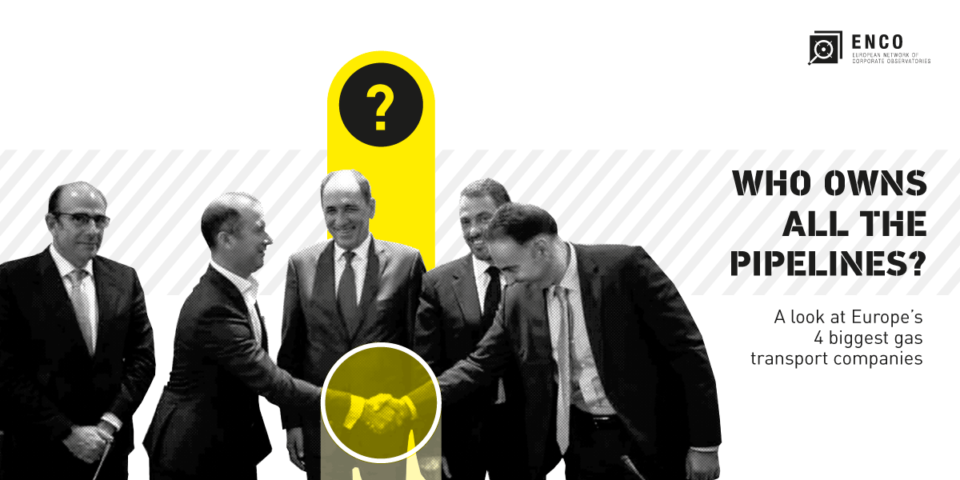A look at Europe’s 4 biggest gas transport companies: Fluxys, Enagás, GRTgaz and Snam
Why is the EU still building new and unnecessary gas pipelines and LNG terminals? Who’s pushing them and who’s profiting from them?
The companies behind Europe’s gas transport network are rarely household names, yet their lobbyists sit at the heart of our political system. They make their money building and operating pipelines and other gas infrastructure projects, and are desperate to keep us hooked on fossil gas, despite the climate science and widespread local opposition.
We take a look at four of Europe’s biggest: Enagás (Spain), Fluxys (Belgium), GRTgaz (France), Snam (Italy) and try and answer some key questions:
- How much infrastructure do they own and who are their subsidiaries?
- Who are their CEOs and who’s on their board?
- How much profit do they make and who are the shareholders filling their pockets?
- What is their lobbying power and who do they pay to do it?
These are important questions as together these little-known gas “transmission system operators” (TSOs) own enough kilometres of pipeline to stretch around the world two and a half times, with plans for more, including controversial projects like the Trans Adriatic Pipeline (TAP). They are going to be key players in deciding if and how we tackle the climate emergency, as well as who pays for it. They’re not to be ignored.
Our two-sided map, available as a PDF and in print-version, visualises not only their pipelines and terminals, but also answers many of these questions graphically. It also includes four company profiles and four case studies of some of their controversial projects.
However, this article goes beyond the company profiles and case studies, providing extra information and analysis not available on the map, digging further into who owns the four TSOs, the consequence of having financial investment funds as investors (what does it mean for leaving fossil fuels in the ground and the just transition?), as well as more information on their lobbying activities.
Descarga el informe y el mapa en pdf.
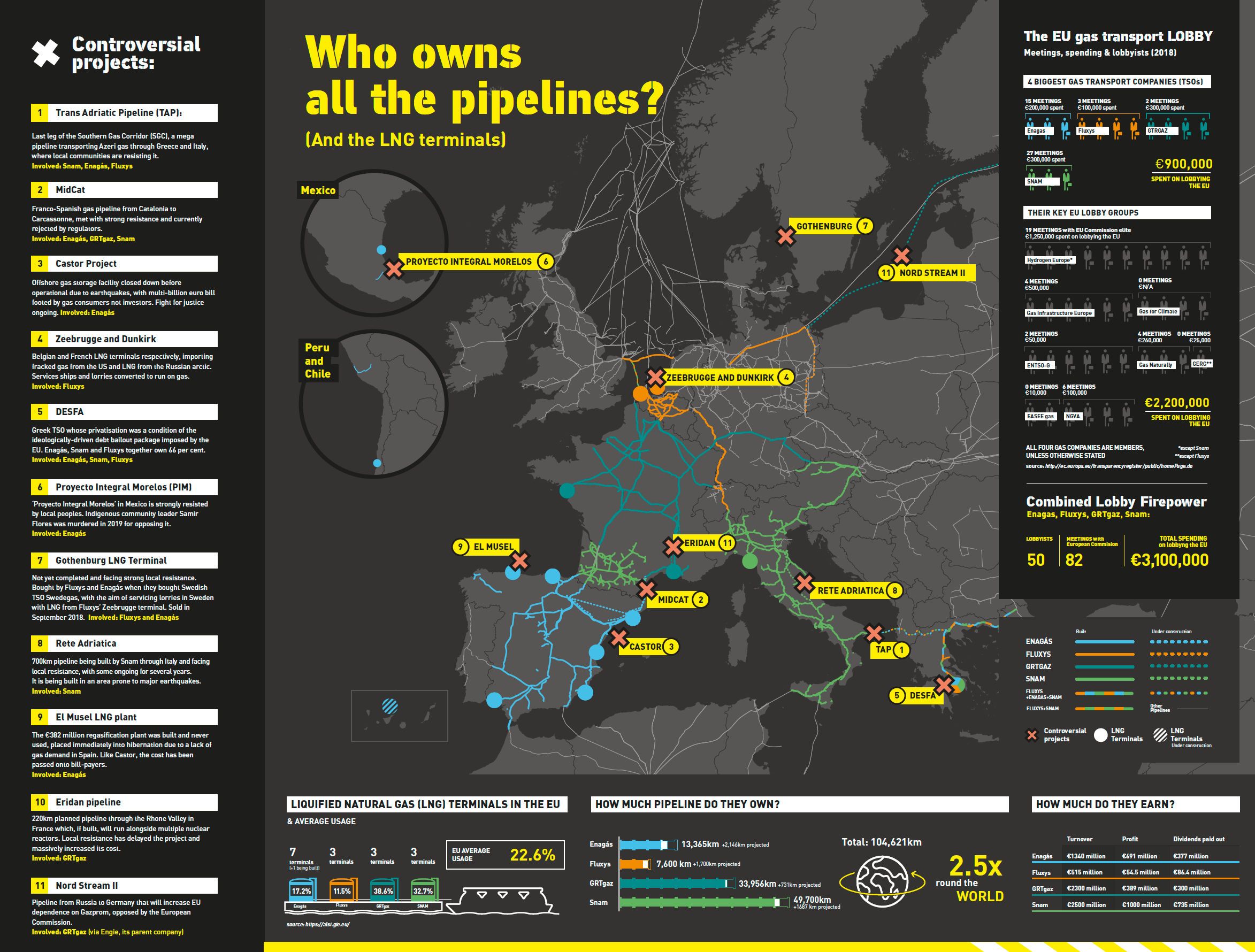
The biggest gas companies you’ve never heard of
Enagás (Spain), Fluxys (Belgium), GRTgaz (France) and Snam (Italy) are Europe’s four biggest gas transporters (TSOs), owning infrastructure across the continent and beyond. Together they own more than half of the EU’s LNG terminals and over 100,000km of pipeline, with new projects planned: 6,200km of pipeline and at least one more LNG terminal are under construction.
All four are run like private companies, despite being publicly-controlled (see more below). They collectively made more than €2 billion in profit in 2018 with almost three quarters paid out in dividends to shareholders such as investment funds BlackRock (GRTgaz and Snam) and Lazard (Enagás and Snam).
In-house and for-hire gas lobbyists
These little-known companies don’t have the profile of Shell, Total or BP, but are just as influential in keeping Europe dependent on gas. The four spent up to €900,000 on lobbying Brussels last year, employing a total of 14 lobbyists. According to the EU’s transparency register, they’ve managed to secure almost 50 meetings with the European Commission’s top political officials to discuss their latest pipeline projects or takeover bids.
As well as their own in-house lobbying operations, the four have invested in a broad network of paid-for lobby groups to push their agenda. This includes their industry trade association Gas Infrastructure Europe (GIE), which sits on a number of the Commission’s influential advisory groups. Handily, SNAM’s CEO Marco Alverà is well-placed to ensure all group are on message. He is currently the President of Brussels-based super-trade association, GasNaturally, which counts GIE as a member, and was previously Vice-President of Eurogas, another GasNaturally member.
Add the figures from Enagás, Fluxys, GRTgaz and Snam with those of their eight key lobby groups, and you hit above €3 million in 2018, with 50 lobbyists at their disposal. Not to be sniffed at when it comes to influencing European gas policy. However, their most important lobbying channel has been created by the EU itself.
Industry calls the shots on EU gas plans
The EU created its own in-house lobby group made up of gas TSOs, called the ‘European Network of Transmission System Operators for Gas’, or ENTSO-G. It counts Enagás, Fluxys, GRTgaz and Snam as members. Despite being composed exclusively of gas companies, the EU tasked the group with providing projections of future gas demand in Europe, which it consistently over-estimates. The EU then asks ENTSO-G to provide it with a list of infrastructure projects to meet the projected demand. After being agreed by governments, this becomes the official list of ‘Projects of Common Interest’ (PCIs), which ENTSO-G members then build with financial and political support from the EU.
€1.3 billion in public money has already gone to projects such as MidCat, the Trans Adriatic Pipeline (TAP) and Fluxys’ LNG terminals. The fourth PCI list will be finalised by the end of 2019, with more than a hundred new gas projects currently included, despite the need to phase out fossil gas completely.
Gas – a false solution
Fossil gas spells disaster for communities and their environments, impacting them wherever it is drilled for or transported. It is also a disaster for the climate. So-called ‘natural’ gas is composed of methane, which is over 100 times more potent than CO2 over a ten-year period. Large quantities of gas leak into the atmosphere during drilling and transportation (particularly when fracking), making gas as bad for the climate as coal, if not worse.
Public companies captured by corporate interests
All of these companies originate in former state-owned national monopolies and retain some level of public ownership. Enagás is only 5% owned by the Spanish state, but with a veto right. Snam’s majority shareholder is CDP Reti, which is controlled by an Italian public financial institution (with a subsidiary of a Chinese state company). Fluxys is owned 75% by Publigas, an inter-municipal holding company. And GRTgaz is 75% owned by energy giant Engie (itself still 24% state-owned) and 25% by a French public financial institution.
The proximity of these companies to national politicians and government bureaucrats is obvious when you look at their boards and leadership:
- Enagás, which has long been a haven for politicians of all stripes, now has a former conservative MEP as a boss, who is also the son of a former minister. Its Chairman of the board is a former socialist minister.
- The chair of Fluxys is the former Mayor of Ghent (until 2019).
- GRTgaz‘s boss is a former high-ranking civil servant that used to be in charge of regulating the gas sector. Revolving doors are in full swing at all levels.
Sadly, this strong public presence does not mean that the now largely private companies are run with the general interest in mind; on the contrary, it means that public shareholding bodies have been captured by private interests, that are all the more influential because of their political connections. When they need special authorisations and state support to suppress resistance to their controversial projects, such as TAP in Southern Italy (see case study), the government is there to help.
Just as it is ready to bail them out at the expense of the public when one of their pet projects fails spectacularly, as was the case with the Castor project in Spain for Enagás (see boxes on TAP and Castor).
Sharing the pie and making it bigger
GRTgaz is probably the one that is still closest to its former public service self, but this is about to change. The French government passed a law in 2019 that allows for a raft of privatisations, including up to 49,9% of GRTgaz. This was justified as a way to help it grow beyond its borders and become a “European champion”. GRTgaz, which already owns gas pipelines in Germany, attempted to unsuccessfully buy out DEFSA, the Greek gas TSO, in 2017 (it was eventually acquired by a consortium of Enagás, Snam and Fluxys). It is said to be in talks with Open Grid Europe, a TSO owned by Australian investment fund Macquarie, which also has gas infrastructure assets in Germany.
This is a process that we’ve seen before in many sectors, from telecommunications to postal services and trains. National public companies have been privatised, sometimes dismantled, merged with foreign counterparts, progressively turning into a handful of giant corporations that dominate the European market and are hugely influential in EU decision-making.
It’s not about competition but about sharing the pie, and coordinating their efforts in Brussels to make the pie grow even bigger, with evermore support to new gas infrastructure throughout the continent.
It should come as no surprise then to see these new gas giants joining forces in controversial projects such as the Trans Adriatic Pipeline (TAP) or MidCat (see case studies), or to buy out remaining national companies such as DEFSA. Our four European pipeline giants now have assets not only in Italy, Spain, France and Belgium, their countries of origin, but also in the UK, Germany, Greece, Austria, the Netherlands, Albania and Switzerland. Next, they set their sights on markets outside Europe. Enagás in particular is already present in Peru and Mexico.
The gas infrastructure binge bringing millions to financial markets
As the “big 4” of gas transport gorge on ever more pipelines and LNG terminals at the expense of the climate and communities, former politicians and corporate executives are not the only ones who reap the profits. Their other shareholders, apart from governments, are large institutional investors, always happy with this kind of risk-free, guaranteed profit kind of asset.
They can be Wall Street managers such as BlackRock (which has a significant stake in GRTgaz’ parent company Engie and in Snam), Lazard (Snam and Enagás) or Goldman Sachs (Enagás). They can be pension funds such as Caisse de dépôt et placement du Québec (Fluxys). Sometimes they can be sovereign wealth funds, such as Singapore’s GIC, which holds more than 30 per cent in Terega, a French subsidiary of Snam.
But they have one thing in common: they love companies to churn out dividends. In 2018, GRTgaz, Enagás, Snam and Fluxys collectively transferred three quarters of their €2bn in profits straight into the pockets of shareholders. Belgian Fluxys gave out even more than it had made in profits, distributing extra cash from freed-up reserves so dividends totalled 160% of profits.
Holding back the energy transition
The pressure on Europe’s biggest TSOs to maximise dividends can also pose problems when trying to transform our energy system in response to the climate emergency. Leaving fossil fuels like gas in the ground would seriously dent the companies’ profits and therefore shareholder dividends.
So instead of talking about how to manage the necessary decline of fossil fuel production, decommission infrastructure and ensure a just transition for workers, the big four TSOs are making new excuses to keep their infrastructure being used. They propose embryonic techno-fixes like so-called ‘renewable gas’ or betting on costly and experimental ‘carbon capture and storage’ (CCS) technology.
All four are aggressively lobbying to have us believe these false solutions will ‘decarbonize’ gas by 2050. In the long-term they claim it would allow industry to meet the EU’s climate targets, but more importantly, in the short- to medium-term, it keeps them in business as we keep using fossil gas waiting for miracles technology to save us. These dangerous distractions are even being used to justify building more publicly-funded fossil fuel infrastructure.
However, with no ‘decarbonized’ gas in sight, shareholder pressure means any new gas infrastructure built today will still be in use by 2050, but based on good ol’ fashioned fossil gas. Or will shareholders be compensated by the public?
Suing to protect ‘lost future profits’
Imagine we do decide to move away from gas, who’s going to pay for it? Shareholder pressure means companies are unlikely to bear the costs themselves. In Spain, Enagás has already passed on the multi-billion euro cost to bill-payers of prematurely closing an offshore gas storage facility (see the Castor case study).
Elsewhere, the Dutch government is being sued by Uniper (previously E.ON) for trying to phase out coal. The German energy company and its investors are claiming compensation under the dangerous ‘Energy Charter Treaty’ for lost future profits. Unfortunately this is not the only instance.
The growing role of investment funds in Europe’s gas transport companies, and their knack at protecting their investments, lays a roadblock in the path to a just transition beyond fossil fuels. It takes democratic control away from workers, communities and decision makers when it is needed most.
If we want these companies to be public in more than just in name, we need to reverse the trend of privatisation and democratise gas transport companies so that they are also ‘public’ in how they behave and who they are accountable to.
Company profiles & case studies
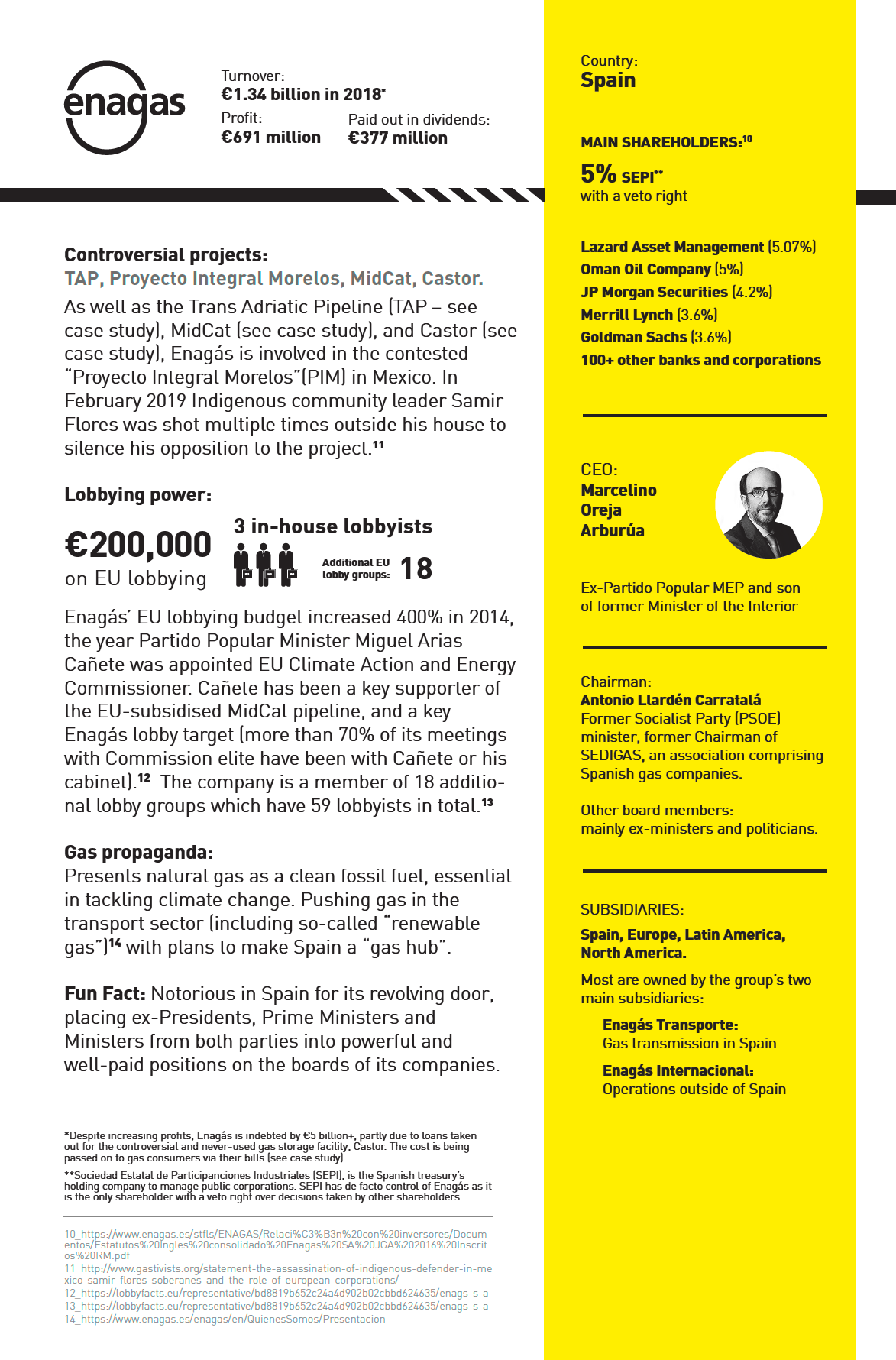
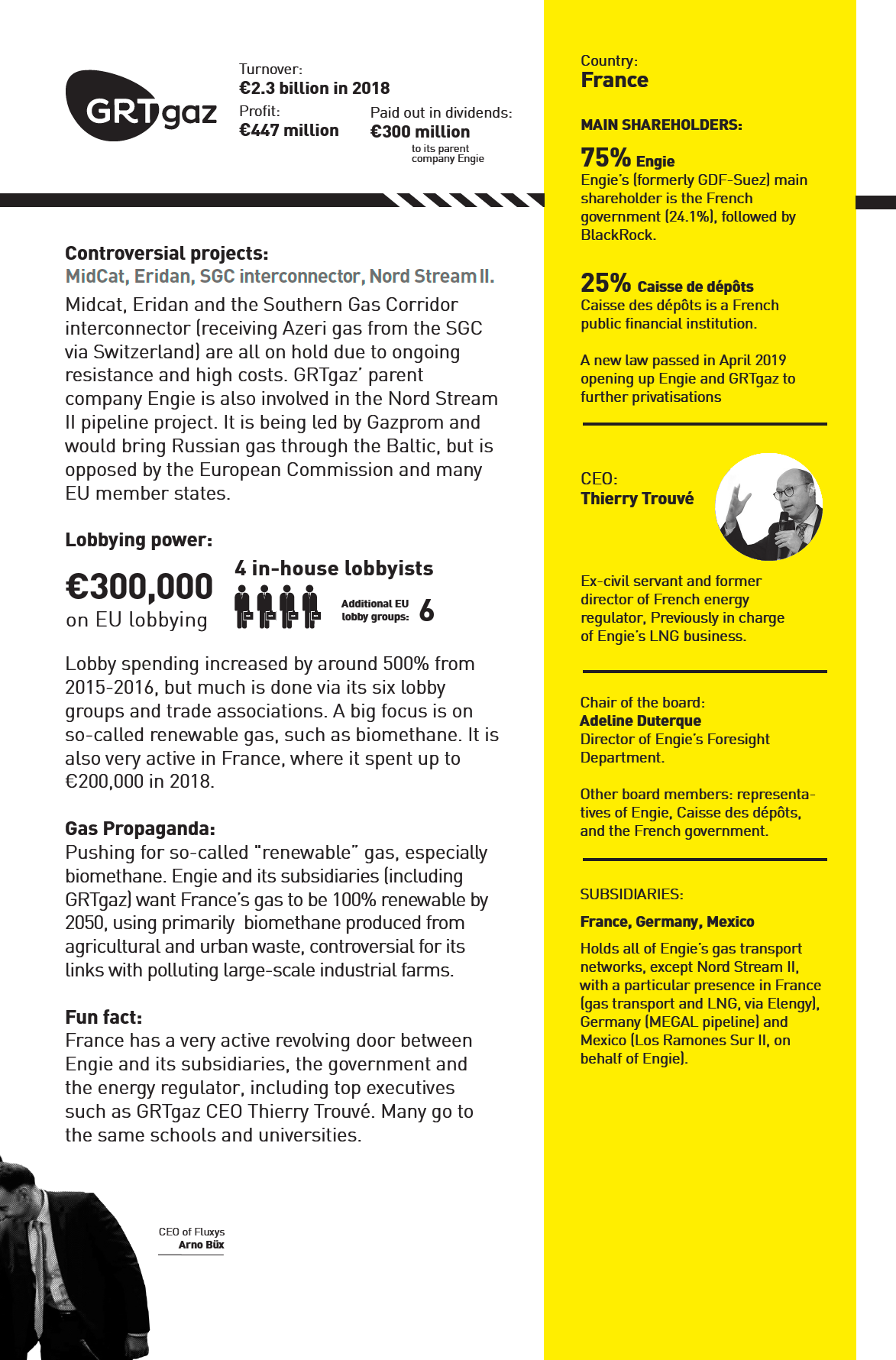
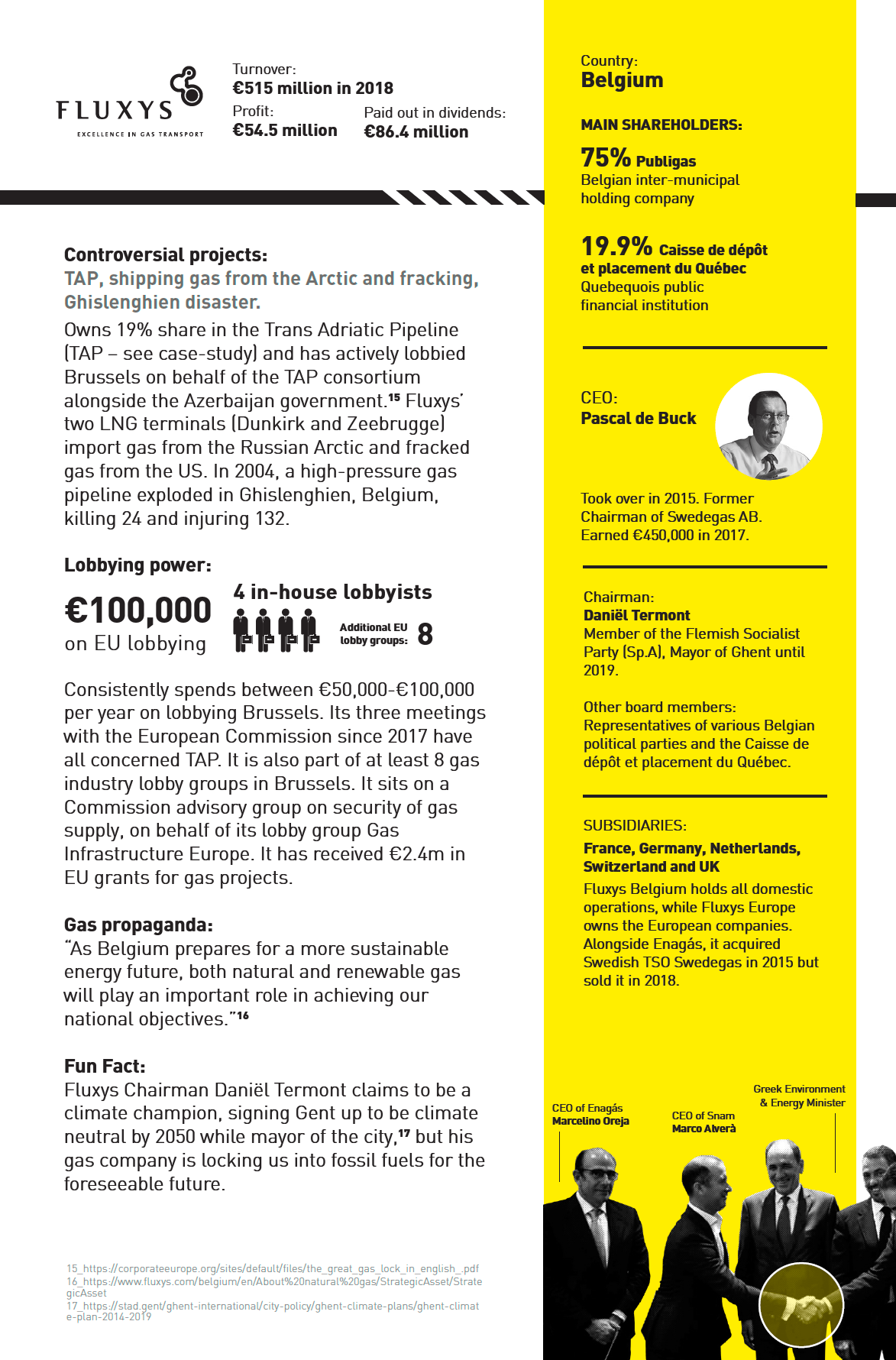
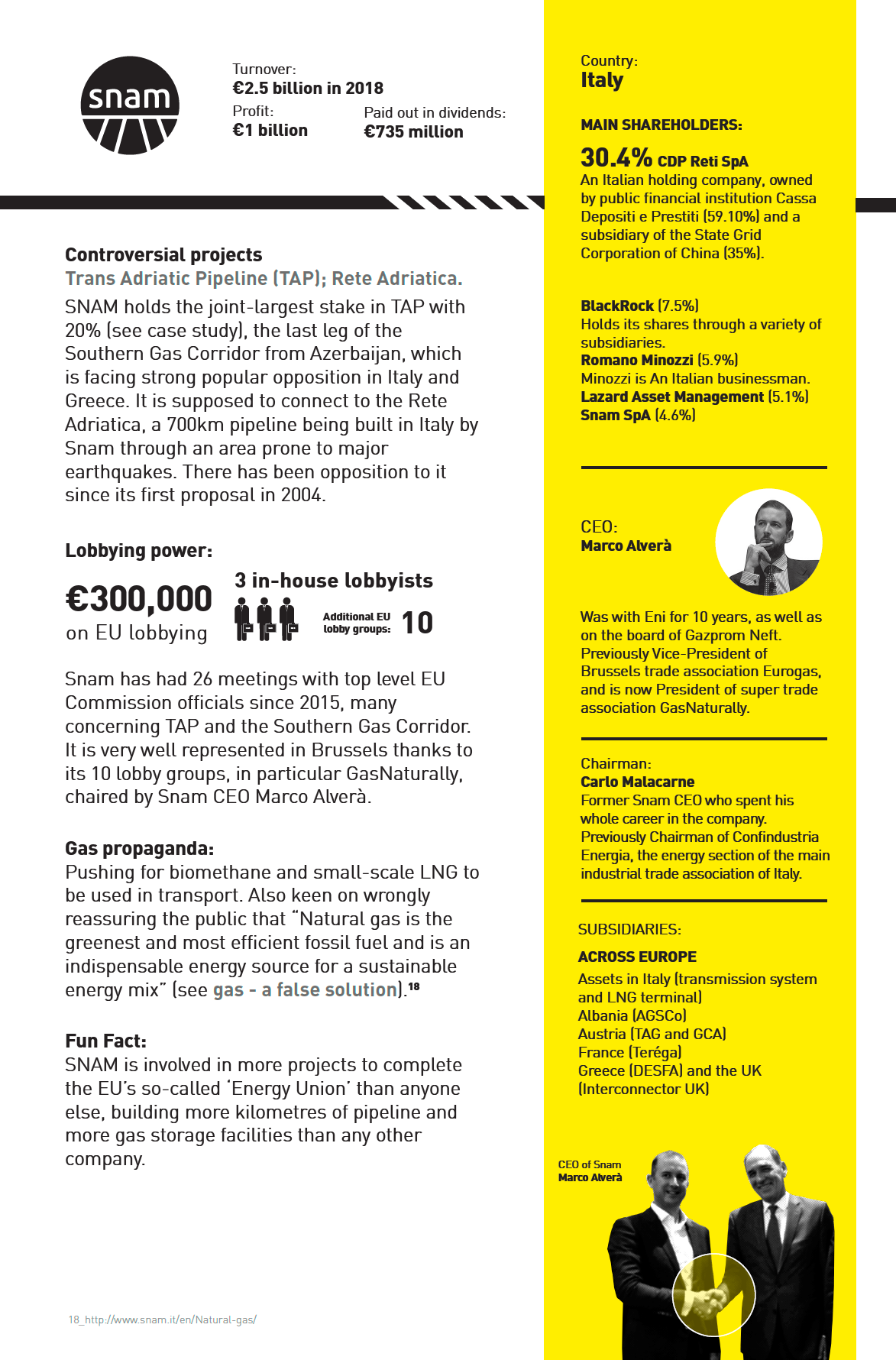
Published by the European Network of Corporate Observatories (ENCO), on behalf of Corporate Europe Observatory (CEO), Gresea, Observatoire des Multinationales, Observatori del Deute en la Globalització (ODG), and Re:Common.
Coordination: Pascoe Sabido
Written by: Pascoe Sabido, Elena Gerebizza, Josep Nualart Corpas, Olivier Petitjean; Romain Gelin
Edited by: Susanna Gendall
Design: Lucía Armiño
Map: Raül Sánchez
Thanks to: Roberta Cowan, Vincent Kiezebrink

